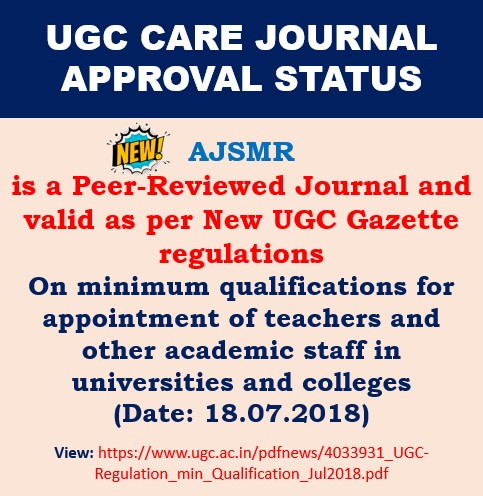Original Research Article I Volume 4 I Issue 3 I 2018
Influence of Andrographolide on the Growth and Development of Corcyra cephalonica (Lepidoptera: Pyralidae)
Madhavi. M, Babu Rao, G
The American Journal of Science and Medical Research; 4(3); 7-11
DOI:http://dx.doi.org/10.17812/ajsmr432
Abstract:
Butterflies are one of the most important assemblages of insects that act as biodiversity indicators as well as nature’s gardeners. Owing to habitat destruction for developmental activities in urban environment and unscientific management of natural resources, much of our native butterflies are fast disappearing and at present, their survival is under threat. The objective of the present survey is focused on the assessment of the diversity and seasonal abundance of butterfly with vegetation composition of habitat and conservation priorities in the study area. A total of 4 species of butterflies were recorded during August-2017to March-2018.This study is aimed towards contributing to the plan of biodiversity restoration in our campus and development of management strategies so as to ensure sustenance of butterflies and ecosystem services derived from them.
Keywords:
Butterfly, species diversity, distance transect method, Nizam College
References:
[1]. Alaruikka,D; Kotze, D.J; Matveinen, K and Niemelä, J (2002). ‘Carabid Beetle and Spider Assemblages along a Forested Urban–Rural Gradient in Southern Finland’. Journal of Insect Conservation, 6:195-206.
[2]. Allred, H.A (1975) ‘Arachnids as Ecological Indicators’. Great Basin Naturalist, 35: 405- 406.
[3]. Balmford, A; Green, M.J.B, and Murray, M.G (1996). ‘Using Higher-Taxon Richness as a Surrogate for Species Richness: Regional Tests’. Proceedings: Biological Sciences, 263: 1267-1274.
[4]. Beissenger, S.R and Osborne, D.R (1982). ‘Effects of Urbanization on Avian Community Organization’. Condor, 84: 75-83.
[5]. Blair, R.B (1999). ‘Birds and Butterflies along an Urban Gradient’:Surrogate Taxa for Assessing Biodiversity. Ecological Applications, 9: 164-170.
[6]. Blair, R.B. (1996). ‘Land Use and Avian Species Diversity along an Urban Gradient’. Ecological Applications, 6: 506-519.
[7]. Blair, R.B and Launer, A.E (1997). ‘Butterfly Diversity and Human Land Use: Species Assemblages along an Urban Gradient’. Biological Conservation, 80: 113-125.
[8]. Brown, K.S.(1991). ‘Conservation of Neotropical Environments: Insects as Indicators. The Conservation of Insects and their Habitats’. Fifteenth Symposium of the Royal Entomological Society of London (eds. N.M. Collins and J.A. Thomas). Academic Press, London.
[9]. Clergeau,P; Savard,J.P.L; Mennechez,G and Falardeau,G. (1998). ‘Bird Abundance and Diversity along an Urban-rural Gradient: A Comparative Study of Two Cities on Different Continents’. The Condor: An International Journal of Avian Biology, 100: 413-425.
[10]. Hager, H.A. (1998). ‘Environmental Effects of Heavy Spillage from a Destroyed Pesticide Store near Hargeisa (Somaliland) Assessed during the Dry Season, Using Reptiles and Amphibians as Bioindicators’. Ecoscience5: 139-147...
Article Dates:
Received: 19 August 2018 ; Accepted: 23 September 2018 ; Published: 29 September 2018
How To Cite:
http://dx.doi.org/10.17812/ajsmr422 Received :9March, 2018 Accepted; 19April, 2018 Available online :28April, 2018



